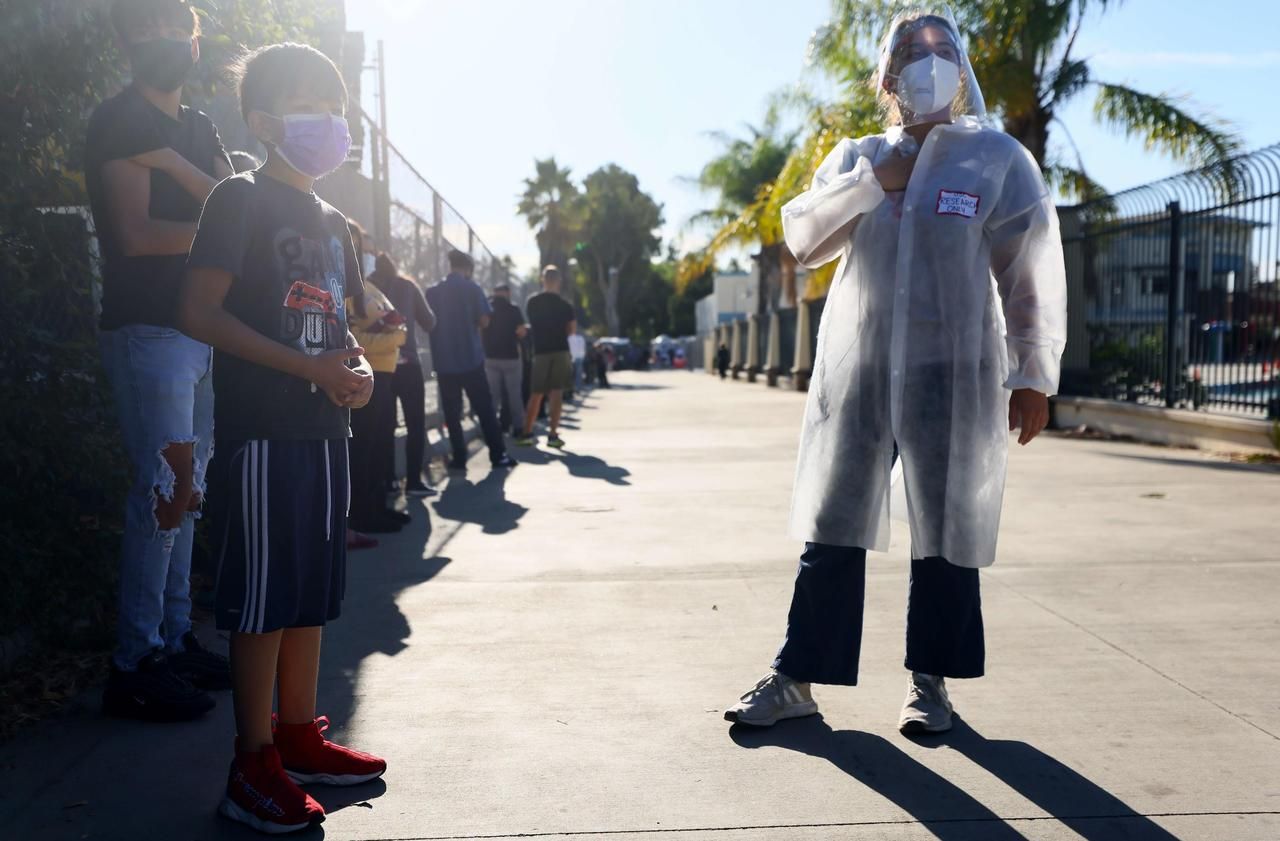The United States is preparing to go through "the most difficult period in the history of the country's public health".
On Wednesday, the director of the Center for Disease Control (CDC) spoke to Americans with extreme gravity.
“The reality is that December, January and February will be tough times,” said Robert Redfield.
The hope of a vaccine against Covid-19 infections may get closer by the day, the new coronavirus is circulating at an unprecedented speed.
Through six infographics, we will show you how the authorities indeed seem to have totally lost control of the contagion.
Especially since the epidemic does not spare any region this time.
1. A record of contaminations reached on Thursday
The United States has just recorded more than 210,000 cases of coronavirus in a single day, an all-time high since the start of the pandemic, according to benchmark data from Johns-Hopkins University.
There are therefore four and three times more positive tests respectively than during the spring and summer waves.
If this comparison clearly illustrates the exceptional circulation of the virus, it also deserves to be put into perspective.
Opposite, the number of screenings carried out each day is also climbing massively.
2. Hospitals have never been so overloaded
100,000. Here is the number of patients hospitalized in American establishments.
That's 40% more than at the peak of the first two waves.
In California, "hospitalizations have increased 86% in the last 14 days," Democratic Governor Gavin Newsom warned Thursday.
The record for severe cases placed in intensive care in the country was also broken in November.
This December 4, the curve is still climbing, without the health authorities being able to predict the imminent arrival of a potential "plateau".
3. An outbreak of deaths soon to equal the level of last April
The country deplored this Thursday more than 2,900 deaths from Covid-19.
A level that had not been reached since the end of April.
This increase is expected to continue for many more weeks in view of the current surge in cases.
According to the average of epidemiological models compiled by the CDC, 300,000 deaths will be reached by early 2021. A figure which we also know that it underestimates the reality: counting the misdiagnosed and indirect deaths, this assessment was actually reached in October.
4. The United States, 12th country in terms of mortality
In absolute terms, American society pays, as we have just seen, the heaviest price.
On the other hand, compared to the size of the population, the mortality across the Atlantic is far from that which can be deplored in Belgium, Peru, Spain or Mexico.
The health authorities thus record 84 deaths per 100,000 inhabitants in the United States, against almost twice as many in Belgium, at the top of this sad ranking.
France is in 19th place (79 deaths per 100,000 inhabitants).
5. The virus was not circulating everywhere during the first two waves
As autumn approached, the specter of a third wave was already present.
However, health authorities imagined that it would be confined to specific areas, such as the first two epidemic outbreaks.
Newsletter - Most of the news
Every morning, the news seen by Le Parisien
I'm registering
Your email address is collected by Le Parisien to enable you to receive our news and commercial offers.
Learn more
The first had mainly concerned the coast in the northeast of the country, in particular New York and its region.
During the summer, it is the large states in the south and west of the country, in particular Arizona, Texas, Florida and California, which have suffered the most from Covid-19.
Since October, it is the northern states of the country, rather spared so far, which have in turn been very affected.
Nebraska is a case in point, like Illinois or North and South Dakota.
6. The virus actually strikes everywhere
From mid-November, the lights turned red across almost the entire country.
With the Thanksgiving holiday making things worse, the statistics speak for themselves today: 45 states reported more cases for a week in November than in any other week since the start of the pandemic, the USA Today site calculated.
According to our calculations, nearly 47 states have even reached their peak of contamination during the last 30 days.
Some have since started to decline, but for the most part, the trend is still exponentially upward.
According to the same methodology, 27 states have recorded the maximum number of disappearances in the past four weeks.
"What we are doing with the Covid here in the United States is not working, sorry Thursday on Twitter Matthew Fox, famous professor of epidemiology in Boston.
What are we going to do different tomorrow to make sure things change?
"
A scattered response
Beyond the concerns generated by the Christmas celebrations, the responses provided by the various governors do not encourage optimism.
Few states are considering re-containment and the restrictions are only reimposed in dispersed order, in the absence of a national strategy from President Donald Trump, who is focused on vaccines.
Shops, restaurants and places of worship remain in many places open, with varying degrees of conditions, and the only governors who have imposed a curfew are those of California and Ohio.
While awaiting his nomination to the White House, Joe Biden tries to be enterprising.
Strong signal, he asked immunologist Anthony Fauci on Thursday to be part of his team on Covid-19.
This highly respected figure is already working with the Trump administration, but the Republican president regularly denies his findings.
In addition, Joe Biden also intends to ask the Americans, on the day he takes office on January 20, to wear a mask for 100 days.
“100 days wearing a mask, not forever.
And I think we'll see a significant reduction (in infections) ”.
A salutary initiative but without any measure with the hope aroused by the imminent arrival of the first vaccines.
Collective immunity and the beginning of a return to normal could then appear around April, May or June, estimates Dr. Fauci.









